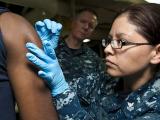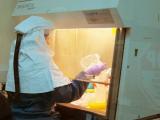May 7, 2012 (CIDRAP News) – Without any major hitches, mail carriers delivered empty pill bottles and fliers to about 37,000 Twin Cities area homes yesterday to rehearse part of the planned response to an anthrax attack or widespread disease outbreak, according to officials involved in the exercise.
Mail trucks hit the streets at 6 o'clock in the morning, and deliveries were completed by about 3 p.m., said Buddy Ferguson, a spokesman for the Minnesota Department of Health (MDH), which led the exercise along with the US Postal Service (USPS).
"We're very, very pleased with the way it went," he said. "I think we've demonstrated that the postal plan is a very promising option for getting people emergency medications during a public health crisis.
"It's not the only way we'd be distributing medicine [in a real disease emergency], but we think it's an important supplement to the medication centers we'd have set up," he added.
In "Operation Medicine Delivery," residents in four zip codes received an empty pill bottle with an explanatory label, plus a flier with information in English and five other languages. The areas included two sections of St. Paul (55101 and 55102), the north side of Minneapolis (55411), and parts of Robbinsdale, Golden Valley, and Crystal (55422).
The four zones were chosen to include a wide variety of housing configurations and delivery requirements for postal workers, the MDH said before the exercise.
Peter Nowacki, USPS spokesman in Minneapolis, said deliveries were made to nearly all the targeted addresses, but a few in Robbinsdale and north Minneapolis were missed.
"We had one section in Robbinsdale that was flooded. We couldn't get to 76 deliveries because of that," he said. "The road was flooded, and they didn't want to take the truck down there." The Twin Cities had heavy rains on Saturday and early Sunday.
Ferguson said a final tally of the number of addresses reached will take a while to figure out.
The bottles and fliers were delivered by 40 two-person teams, each consisting of a mail carrier and a law enforcement officer, according to Nowacki and Ferguson. Each team covered at least two normal mail routes, Ferguson said.
"The law enforcement person is there to protect the postal worker, not to protect the medicine," he said. In a real emergency, he added, the MDH should have an ample supply of medicine from the national stockpile, and it would be provided free, so "there's really no reason for anyone to think about stealing the medication."
The Twin Cities area is one of five cities around the country that are working on federally funded programs to use the USPS to respond to a bioterrorist attack. Others are Boston, Philadelphia, San Diego, and Louisville, according to previous reports.
The strategy has been tested in smaller, more preliminary exercises in a few of the cities. But MDH officials said the Twin Cities area was the first to recruit a full complement of postal volunteers and set up a fully developed delivery system. About 300 mail carriers have been trained, according to previous reports.
An advance publicity campaign seemed to succeed in preparing residents for the exercise, because few called the MDH with questions, officials said.
"We did some pretty extensive messaging ahead of time—we delivered cards to residences on Tuesday [May 1] letting them know," said Nowacki. During the exercise, "We were pleasantly surprised at the awareness in the communities."
By noon yesterday the MDH had received only one call on its hotline, Ferguson said, adding, "We know a lot of people didn't check their mailboxes till today, so there might be some more calls yet."
Nowacki said that ECHO Minnesota, another organization involved in the test, had received three calls. The group works to provide multi-language communication with immigrant and refugee groups about health, safety, civic engagement, and emergency preparedness.
Ferguson said the agencies involved in the exercise plan to conduct a thorough evaluation to find out what went well and where problems cropped up, a process that may take anywhere from several days to 2 or 3 weeks.
A major aim of the exercise was to see how quickly medicine could be delivered, Ferguson noted. The test was based on a hypothetical airborne anthrax attack, which would require providing antibiotics quickly to all those potentially exposed.
"Our primary tool for doing that would be special medication distribution centers, operated by local public health agencies and located throughout the metro area," Minnesota Health Commissioner Dr. Ed Ehlinger said in a pre-exercise press release. But postal delivery to some areas could take some pressure off the medication distribution centers, he said.
Other government agencies involved in the exercise included local law enforcement agencies, St. Paul–Ramsey County Public Health, and Hennepin County. Funds for the MDH activities were provided by the US Department of Health and Human Services, and Ferguson said some officials from the Centers for Disease Control and Prevention were on hand.
See also:
May 3 MDH release
http://www.health.state.mn.us/news/pressrel/2012/opmeddelivery050312.html
MDH fact sheet
http://www.health.state.mn.us/oep/postal.html
Mar 21 CIDRAP News story "Twin Cities to test mass delivery of emergency meds by mail"


















